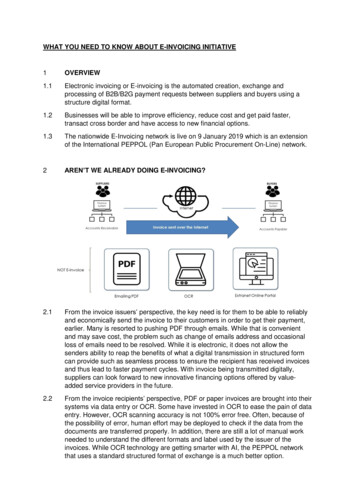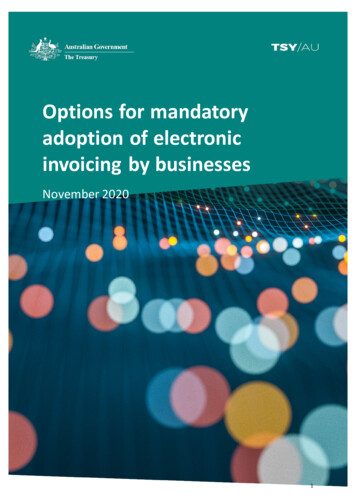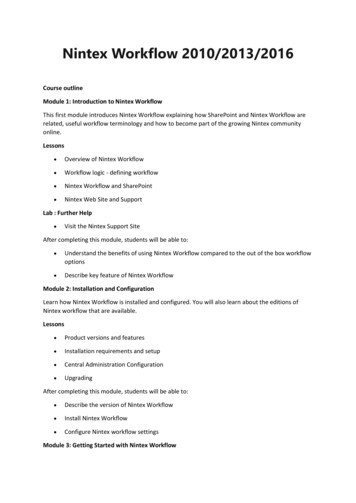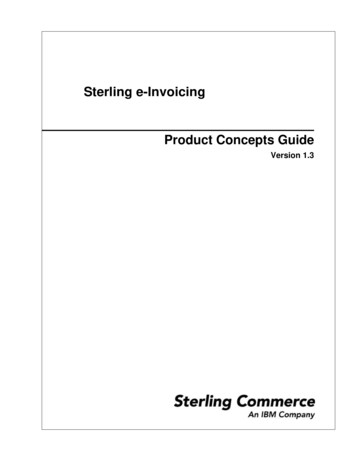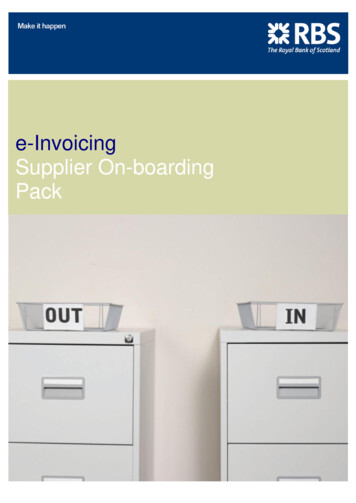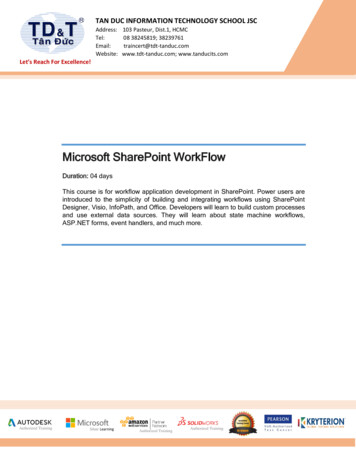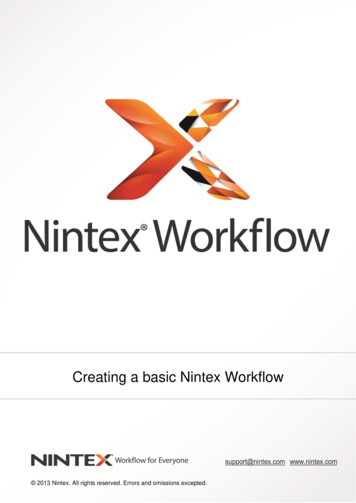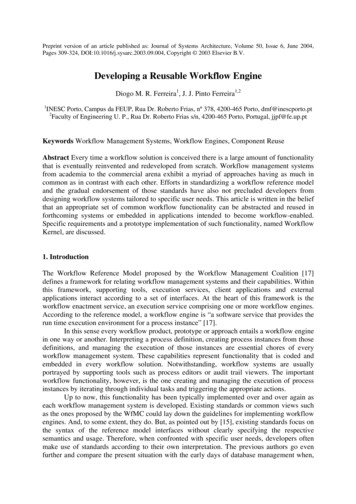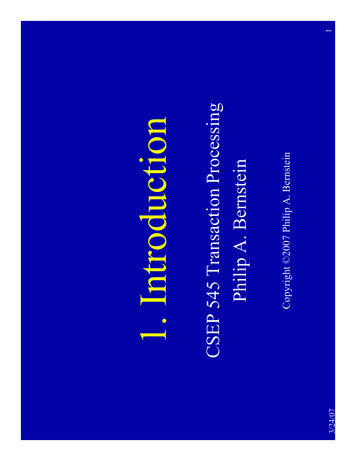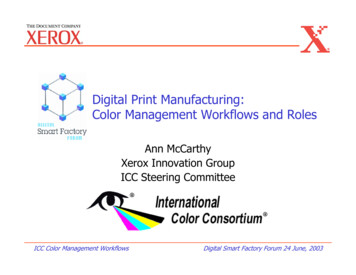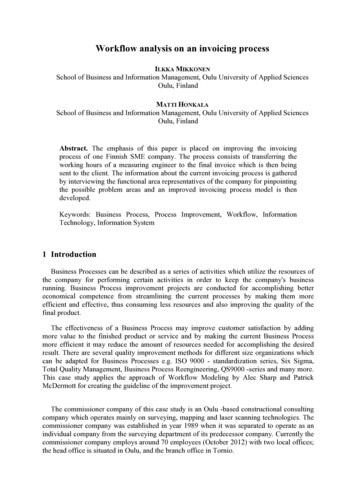
Transcription
Workflow analysis on an invoicing processILKKA MIKKONENSchool of Business and Information Management, Oulu University of Applied SciencesOulu, FinlandMATTI HONKALASchool of Business and Information Management, Oulu University of Applied SciencesOulu, FinlandAbstract. The emphasis of this paper is placed on improving the invoicingprocess of one Finnish SME company. The process consists of transferring theworking hours of a measuring engineer to the final invoice which is then beingsent to the client. The information about the current invoicing process is gatheredby interviewing the functional area representatives of the company for pinpointingthe possible problem areas and an improved invoicing process model is thendeveloped.Keywords: Business Process, Process Improvement, Workflow, InformationTechnology, Information System1 IntroductionBusiness Processes can be described as a series of activities which utilize the resources ofthe company for performing certain activities in order to keep the company's businessrunning. Business Process improvement projects are conducted for accomplishing bettereconomical competence from streamlining the current processes by making them moreefficient and effective, thus consuming less resources and also improving the quality of thefinal product.The effectiveness of a Business Process may improve customer satisfaction by addingmore value to the finished product or service and by making the current Business Processmore efficient it may reduce the amount of resources needed for accomplishing the desiredresult. There are several quality improvement methods for different size organizations whichcan be adapted for Business Processes e.g. ISO 9000 - standardization series, Six Sigma,Total Quality Management, Business Process Reengineering, QS9000 -series and many more.This case study applies the approach of Workflow Modeling by Alec Sharp and PatrickMcDermott for creating the guideline of the improvement project.The commissioner company of this case study is an Oulu -based constructional consultingcompany which operates mainly on surveying, mapping and laser scanning technologies. Thecommissioner company was established in year 1989 when it was separated to operate as anindividual company from the surveying department of its predecessor company. Currently thecommissioner company employs around 70 employees (October 2012) with two local offices;the head office is situated in Oulu, and the branch office in Tornio.
The main customers of the commissioner company are:1) construction companies2) public sector (which consists of cities and municipalities mainly in northern Finland)3) factories and plantsThe commissioner company mostly offers surveying engineering consulting serviceswhich includes: geodetic surveying, high-precision on-site surveying, GPS surveying, andLaser scanning services. Due to the rapid growth within the commissioner company betweenthe years 2000 and 2010, the information systems which support the key Business Processes,have not been developing correspondingly which have brought some slight problems withinthe organization. [1]Fig. 1. The growth of the commissioner company between years 2000-2010The growth within the commissioner company occurred rather slowly, until theconstructional boom preceded by the economic growth of the late nineties and early 2000’s inFinland, expanded the company to be one of the biggest surveying engineering companies inFinland. Between the years of 2000 and 2008 the company growth was so rapid that theamount of employees nearly tripled which can be seen in figure 1 and the turnover of thecompany had a quite massive five-fold increase which can be seen in figure number 2.
Fig. 2. The development of turnover between years 2000-2010The following chapters present a case study on the invoicing process of the commissionercompany. The study was performed by Matti Honkala from Oulu University of AppliedSciences. The study is presented in detail in his BBA thesis. [2]2 Research Methods – The Workflow ModelingThe main methodology utilized conducting this Business Process Improving -project isbased on a book of Workflow Modeling - Tools for Process Improvement and ApplicationDevelopment by Alec Sharp and Patrick McDermott. The main methodology can beunderstood as a certain type of variation of Business Process Management –approach.Although the authors states that it is more practical and concise to this type of modelingproject, when comparing to other Business Process Management -methods. [4]When the Six Sigma –project’s most popular Process Improvement methodology consistsof five phases of improvement (Define - Measure - Analyze - Improve - Control) [3] themethodology applied with this certain approach is called the three-phase project-orientedmethodology. These three improvement phases are as follows:1) Establish process context, process scope and the goals of the process2) Understand the as-is-process-workflow and other enablers, and3) Define to-be process characteristics and requirementsThe goal of the phase number one is to conduct an Overall Process Map of the processunder improvement project. Sharp & McDermott describe the Overall Business Map as “asimple graphical depiction of a set of related processes (sub processes), usually amount of fiveto seven”. The Overall Process Map is being conducted for recognizing the series of BusinessProcesses in the particular process area and also comprehending their relationships and linkedconnections to each other.
When the Overall Process Map is being conducted, it is then possible to come up with acomplete, thorough understanding of the boundaries of the whole Business Process Improving-project. What of these processes are being taken into deeper consideration, and what of theprocesses are completely out of the context? Sharp & McDermott also states that: “the valueof the Overall Process Map is that it also clarifies what is out of scope as well as what is in”.When the Overall Process Map is being conducted and the scope for the project is clarified,the As-Is-Process can be modeled. In this phase of the project, the actual visual modeling ofthe processes takes place and the swimlane diagrams are being developed.2.1 Swimlane diagramsThe swimlane diagrams are a certain type of Process Flow Diagrams which are used forshowing the entire Business Process under investigation, from its beginning to an end. It isalso common to say that the workflow model depicts the three R's; 1) Roles, 2) Rules and 3)Routes of the Business Process. In this context, these swimlane diagrams are being applied forvisualizing the As-Is- Process workflow as well as the To-Be-Process workflow.Because of their ease of use, the swimlane diagrams are being widely used with differentBusiness Process improvement methods; for example Business Process Modeling Notation(BPMN) by Business Process Management Initiative (BPMI) and also with the UnifiedModeling Language (UML) as the Activity Diagrams. [4]The swimlane diagrams are also applicable with this particular context because thediagrams seem to be relatively simple and concise to conduct and also simple to understand.In a nutshell - the swimlane diagrams simply just show 1) what is done, 2) by whom, 3) and inwhat sequence. The main elements which will constitute the swimlane diagrams are: 1) theactors involved, 2) the steps they accomplish in the process, and 3) the flow of work betweenthem. [4]The actors of the swimlane diagrams can be understood as “swimmers” (hence the nameswimlane) who does the work within the process on each of the swimlane. Therefore, with thehorizontal swimlane diagrams, the actors of the process are being listed on the left side of thediagram. Each of the actors will have their own designated swimlane assigned which extendsfrom left to right, across the diagram, therefore there should be no overlapping or whatsoeverwhen the work is being "floated" through the entire process.The transition, when the work flows from one actor to another, is called a handoff; whichcan actually happen in real life when one actor of the process physically hands out e.g. aprinted document to another actor of the process to use. The line, which separates theswimlanes of two actors, indicates that the completion of the preceding step can beunderstood as a precondition for the initiation of the following step. Furthermore, theswimlane diagram shows the previous steps - which have to be fully completed - before thenext step of the swimlane diagram can begin.In figure number 3 we can see an example of a simple horizontal swimlane diagram fromschool’s semester enrollment process. Each of the individual process actors are placed ontheir designated swimlanes; also the handoffs and the process’ boundaries can be seen veryclearly on this diagram example.
Fig. 3. A simple swimlane diagram (Sharp & McDermott 2009, 204) [4]3 Studying the current invoicing processThe invoicing process in the commissioner company has been almost similar since year1998 after the currently used MS Access –based timesheet software has been taken into use.The biggest differences with the invoicing process at the time were that the Chief ExecutiveOfficer of the company handled the invoicing of the customer only by himself. The workinghours were collected by using the same MS Access –timesheet database and by the workinghour data from the monthly timesheets the invoices were able to be compiled by using theNova financial administration-system. The commissioner company still uses the Novafinancial administration-system although it had been through several version upgrades sinceyear 1998.At the time, when the invoicing process of the commissioner company was managed bythe previous Chief Executive Officer, the size of the organization made it possible to managethe invoicing process as a part-time-basis, but later on when the organization expanded, itbecame apparent that the workload had to be balanced in order to successfully managing theinvoicing of the customer. Therefore the Financial Manager was being hired to thecommissioner company.When the invoicing process of the commissioner company was being managed by theprevious Chief Executive Officer, the financial management software was being applied onlywith compiling and printing the invoices, therefore it was not fully integrated within the
invoicing process. The customer payments were verified by manually examining the bankstatements - and if needed, the reminders were sent to the customers. The manual verificationof the customer payments later on revealed to be somewhat time-consuming process andwhen the automated payment verification was taken into use, it was possible to perform theinvoicing faster and effectively. [1] Shortly after the current Financial Manager was beinghired to the commissioner company, the financial management software was fully integratedinto the invoicing process, and the verification of the customer payments became smoother;since the financial management software can be integrated with the banking systems, the bankstatements can be automatically downloaded to the financial management software and theverification of the payments went as it is supposed to go by using a financial managementsoftware.The Financial Manager was fully responsible for the invoicing process until year 2004when a part-time assistant was being assigned for correcting the monthly timesheets andsending the final invoices to the customers. At the time, the size of the commissionercompany's organization made it possible to perform the invoicing process with part-timeassistant, but when the organization expanded even more, nowadays the commissionercompany has hired Financial Management Assistant to work with the invoicing processesfull-time.The studying of the current invoicing process was conducted by gathering the informationabout the process by interviewing the functional area representatives. The process under studyis the as-is invoicing process of the commissioner company, and the process itself involves anumber of personnel; the Surveyor, the Financial Management Assistant, the FinancialManager, commissioner company’s contact person in Tornio Office and also the ChiefExecutive Officer of the commissioner company. The functional area representative - orrepresentatives - of this particular process are the Financial Manager and the FinancialManagement Assistant so they are being interviewed for gathering the needed information ofthe process. The interviewing of the functional area representatives should have taken placeon each of the three main steps throughout the project - if the three-phase project orientedmethodology was being followed perfectly, that is. This particular project is being conductedunder the time restrictions of Bachelor's Thesis, therefore the interviewing of the functionalarea representative(s) is being conducted during the first step of the project only (establishprocess context, scope and goals) for uncovering the necessary information about the processfor conducting the swimlane diagrams. By interviewing the functional area representatives itis possible to uncover 1) the scope of the process, 2) set of related Business Processes and 3)also the activities of the connected processes. The scope of the process under study can beestablished by using the framework of the process boundaries and contents by Sharp &McDermott [4]. The process boundaries should reveal the what, who and how of the process:What - triggering event, result for the customerWho - actors and organizations participating in the processHow - systems and mechanisms supporting the processThe developing-phase of the swimlane diagrams will be conducted after the As Is Processand the goals of the process are clarified and understood. Due to the author's long workinghistory with the client company, the interviews were held rather informally therefore therewill be no specific interview framework applied with the interviews. Also the OverallBusiness Process map will be conducted by cooperation with the functional arearepresentatives.
4 Modeling the invoicing processThe modeling of the invoicing process was done by using the aforementioned service-levelswimlane diagrams which can be created for modeling the whole process with one and simplediagram. Swimlane diagrams can also be used when the subprocesses of the invoicing processare being modeled; therefore it is most suitable modeling technique for this kind of BusinessProcess improvement project. The modeling of the invoicing process should cover the wholeprocess from beginning to an end, the phases (subprocesses) and also the actors who performthe activities with the process under study.The process in the appendix number one was being modeled by creating the service-levelworkflow diagram of the invoicing process as it was in year 1998, before the current FinancialManager was responsible for invoicing the customers of the company. The process in theappendix two depicts the invoicing process as it was in year 2000 when the FinancialManager was being hired to the commissioner company. The current invoicing process wasmodeled by creating similar service-level diagram than in appendix one and two.During the interview sessions it was possible to come up with the invoicing process phasesof the current invoicing process. The phases were categorized by using the three-phase projectoriented methodology as processes with connected subprocesses, and the redundant processphases were integrated with the subprocesses.3 Results and conclusionsWhen the stakeholders of each of the sub-processes of the Invoicing Process wereinterviewed, it became obvious that the biggest problems and delays with the currentInvoicing Process happen with the current timesheet collecting process; and due to the factthat by using the current timesheet database the employee of the commissioner company whois willing to add the working hours to the database have to be physically situated inside eitherone of the commissioner company’s offices, inside the head office in Oulu or the branchoffice in Tornio. And also the current timesheet-database software cannot be modified so thatit could be used remotely via Internet-connection. Therefore the transformation of thetimesheet-database is justified.As the transformation of the timesheet –database goes as planned, each of the employees ofthe commissioner company has the possibility to add their working hours to the timesheetdatabase remotely, and also to remotely use the project database of the timesheet system. Theproject database is located inside the timesheet software and it consists of almost everycustomer of the commissioner company with their contact information, therefore it makes itpossible to find the information about customers and the previous projects by using the samedatabase system.The outcome of this study can be seen with the swimlane diagrams and with thecomplexity of the overall invoicing process. The process itself will be extensively improvedafter the planned internet-version of the timesheet database will be released.
By applying the current invoicing process it takes usually around two weeks to gather themonthly timesheets from every employee of the commissioner company, which from thefinancial management point-of-view can be somewhat frustrating to wait this long until theinvoicing actually can begin. With the internet-version of the timesheet-database, that time forgathering the timesheets can be significantly shorter. That is, due to the fact that each of theemployees will have the opportunity to add their working hours into the database by onlyusing the internet-connection and the employee does not have to be physically situated incommissioner company's premises when using the timesheet-database.Although the improvement of the timesheet-database does not rule out the fact that theemployees of the commissioner company are still the ones who are responsible for adding theworking hours to the database, and if they are not willing to take the internet-version of thetimesheet database extensively into use (and therefore continue sending their working hoursvia email) the usefulness of the improved invoicing process can be futile.Also the usability of the timesheet-database should be on that level in which the employeedoes not feel the using of the software too challenging or time consuming thus the employeesof the commissioner company doesn't necessarily need any training for successfully using theupgraded timesheet database system. The usability-issues were being handled by usingsomewhat similar user interface as with the previous timesheet-database software by using thebasic functionalities of the previous timesheet system as a template for the functionalities withthe improved timesheet system, thus the similarity should encourage the employees to easilymigrate using the improved version of the timesheet-database.The invoicing process has been mostly identical when comparing the processcharacteristics with years 2000 and 2010. The company growth has occurred quite rapidly,and the invoicing process has expanded to involve total number of 7 persons at the most.When comparing to year 2000 the invoicing process involved only 3 persons (the Surveyor,the Chief Executive Officer and the Customer). On assumption, the invoicing process wouldbe a bit simplified in a way, e.g. the role of the Chief Executive Officer with the invoicingprocess can be taken into consideration since he is largely involved on both, correcting thetimesheets and approving the final invoices. And when the Chief Executive Officer is notsituated at the company premises, the process of invoicing stays in "idle state", thus theprocess is not moving forward as it is supposed to.The methods of reducing the role of the Chief Executive Officer with the invoicing processcan be e.g. dividing the projects due to their characteristics as the ones which can be approvedby the Financial Manager and the ones which will need the Chief Executive Officers "stampof approval". Therefore the Chief Executive Officer does not have to use the time for goingthrough every invoice of the invoicing period. This method only needs some arrangements inthe beginning of the project and mostly with the invoicing terms so that later on the finalinvoices does not necessary need the Chief Executive Officer's approval.Also the process when the Chief Executive Officer approves the invoices could besmoother as there seems to occur some redundant printing of the drafts of the final invoiceswhich could be replaced by using the electric documents which can be sent via email and
therefore the Chief Executive Officer does not necessarily have to be situated inside companypremises for making his corrections to the invoices. These electronic documents are possibleto print out from the invoicing software quite easily, thus it seems as a natural step ofimprovement with the invoicing process.Literature1. Holappa, P.: Interviews, 12.10.2010 and 19.9.2011.2. Honkala, M.: Workflow analysis of invoicing process for Mitta Oy, Bachelor thesis, OuluUniversity of Applied Sciences, Oulu, 2011.3. Laguna, M., Marklund, J.: Business Process Modeling, simulation and design. UpperSaddle River, NJ: Pearson/Prentice Hall, 2004.4. Sharp, A., McDermott, P.: Workflow Modeling: tools for process improvement andapplication development. Norwood, MA: Artech House Inc., 2009.Contact data:Ilkka MikkonenHead of Degree Programme in Business Information TechnologyOulu University of Applied SciencesTeuvo Pakkalan katu 19FI-90100 Oulu, Finlandilkka.mikkonen@oamk.fiMatti Honkalamathonka@mail.student.oulu.fi
APPENDIX 1
APPENDIX 2
APPENDIX 3
APPENDIX 4
The invoicing process in the commissioner company has been almost similar since year 1998 after the currently used MS Access -based timesheet software has been taken into use. The biggest differences with the invoicing process at the time were that the Chief Executive Officer of the company handled the invoicing of the customer only by himself.
